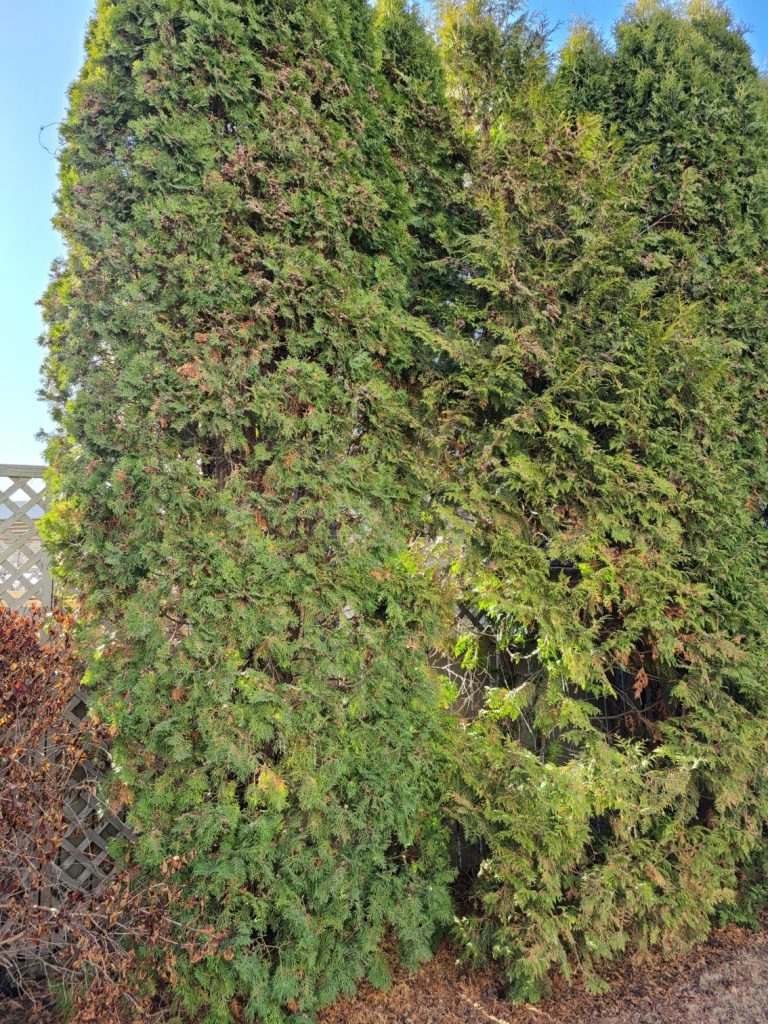
Hi
I am having problems with my cedars thinning. I live in Saskatchewan, Canada where we have long cold winters and spring is only just starting now. I have no idea how old they cedars are but they were large when we bought the house 6 years ago. They act as a privacy screen so I really want to get them healthy again.
It all started last year, when they had dropped a lot of needles at the end of winter beginning of spring. At the beginning of spring our arborist said to feed them now and water regularly, which I did all year but they don’t seem to have improved. The cedar on the right in the picture is the worst, with the other 10 looking like the one on the left. The one on the right is a different cedar to the others, a white cedar I think, that they must have put in by mistake years ago. It does seem to be putting some growth on in the bare patch from the trunk.
I bought a sprinkler hose which I put under the cedars and turned on every 2 days for an hour, 24 hours later the ground feels wet as far as I can put my fingers in. The hose is a sprinkler on the top and soaker underneath. I have this running directly under the cedars, should it be more at the edge on the drip line?. Do you think this is sufficient water?
There is now a lot of dead leaf matter on the ground, should I remove it (I did last year)?. I’ve read I could mulch but I’m not sure what with, is it worth top dressing with compost?
I’ve also read I could sheer to encourage bushing but some people say spring, some say early summer and some say both. What is the best way, how much and when?
I really want to do whatever I can to save these guys and would really appreciate any help.
Thanks in advance
Thank you for your question. Your trees look like emerald cedars, also known as arborvitae. We do get many questions about these cedars. Often people ask about cedars turning brown especially after the winter season.
The article Why Are My Emerald Cedar Leaves Turning Brown? https://www.thespruce.com/why-are-my-emerald-cedar-leaves-turning-brown-2132818 outlines various reasons why cedar leaves turn brown.
It is normal to see some brown leaves on the inner part of emerald cedars in fall or spring, as the emerald cedars are shedding foliage. However, browning on the outer tips is more problematic and can be symptomatic of a number of problems. In the case of your trees, given your arborist’s recommendations, the browning is likely due to watering issues.
Now, to answer your questions
- Watering
Evergreens are susceptible to winter injury or burn. This occurs because winter winds draw moisture out of evergreen leaves. The plant roots are unable to take up water from the frozen soil to replace this lost moisture, and evergreen leaves dry out.
In the fall, watering evergreens right up to until freeze up is very important to prevent winter desiccation.
During the growing season, water evergreens thoroughly on a regular basis so the roots do not dry out, especially if summers are hot and dry. Watering deeply and less frequently is recommended. Established plants need about 1.5 cm (1/2 inch) water weekly, either through rainfall or irrigation. Too little water will cause the foliage to turn yellow or brown, while excessive water may cause needle discoloration and root rot.
I suggest you water your cedars less frequently, say once per week, and only if there is insufficient rain. We recommend using a drip irrigation hose which allows the ground to become soaked down to root level. However, your sprinkler/soaker hose should work adequately. I would lay the hose between the tree trunk and the drip line.
- Mulch
Mulching under your cedars is a good idea to hold moisture in the root zone, deter weeds and shade your cedars’ roots. Apply a 4-5 cm layer in spring, and keep the mulch at least 3 cm away from the trunk of the tree. Shredded bark mulch or even fallen leaves will work.
- Fertilizing
You do not say how you fertilized the cedars. Fertilizer should be applied in early spring to encourage new growth. Evergreens require a lot of nitrogen, so 30-10-10 is an appropriate choice of fertilizer.
In addition, top dressing with organic material every year is also a good practice to maintain the nutrient level of your soil.
There is no need to remove the dead leaf matter. Leave it on the ground to compost and provide organic material.
Here is a detailed discussion of fertilizers for emerald cedar hedges from one of our previous posts: https://www.torontomastergardeners.ca/askagardener/fertilizing-emerald-cedar-trees/
- Trimming/pruning
You can prune the cedars by removing as much as 1/3 of the foliage every year, to bring the shape under control. If you prune the tops, more sun can reach the cedars’ lower branches, encouraging growth. Don’t remove too much off the top though – remove under ¼ of the height, since the tree will grow slowly from the top.
You may wish to visit the “Ask a Master Gardener” website and search the term “cedar” for more useful information about cedars.
Good luck.

